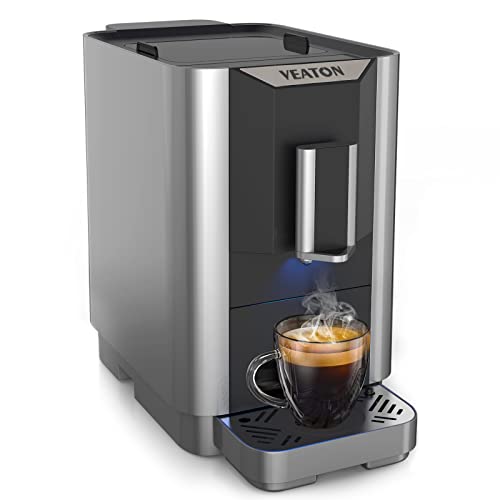How Does Machine Espresso Work?
Machine espresso employs precise pressure and mind-blowing filter technology to create the delicious coffee we enjoy. How does it work exactly?
Espresso is made by pushing hot water under pressure through finely-ground coffee. The process is similar to making drip coffee, however the main difference lies in the pressure.
The Head of the Group
As the name suggests, the group head is the place you put your portafilter in when brewing espresso. It is responsible for dispersing the water into the portafilter and controlling the pressure of the extraction. There are a variety of group heads each with distinct advantages and drawbacks. Some are designed to provide temperature stability while others are built to handle pre-infusion. Some are designed to control the lever. There are even some that have a combination of features, like the E61, which is considered the classic choice among many baristas because of its ability to offer multiple benefits in a single package.
As you can see in the photo above, the group head has many notches in which you can place your portafilter before twisting it manually to secure it. There is also a gasket of rubber that is a part of the notches and helps to create an airtight seal after inserting your portafilter into the machine. The notches on the head permit a precise position of the portafilter which is crucial for an even extraction.
Apart from allowing you easily place your portafilter in, the group head is responsible to ensure that the temperature remains even. This is done by cycling hot water around the portafilter, and through the brew-basket to ensure that the temperature is always at the right level to extract the coffee. This is vital, because just a few degrees could be the difference between a excellent and great espresso.
The Pump
The motorized pumps used in espresso machines rotary provide nine atmospheric bar pressure that is required for espresso extraction. This differs from manual piston machines which use a lever. This pressure builds up by removing tap water from a reservoir, and pumping it through a heat exchanger prior to being pushed through the ground coffee inside the group head.
Pumps are generally more affordable and last longer than piston-driven machines. However, both types of machines may degrade due to excessive use and poor cleaning. Pumps are also more complex mechanically, and can add to the price of even the most basic models.
Certain espresso machines can eliminate the pump completely and utilize steam pressure to make espresso. The disadvantage of this is that the boiler that produces steam also increases the temperature of the water until it reaches boiling and can result in over-extraction. Additionally, these machines frequently have to restore their pressure between cups, which takes time and energy.
Many espresso machines make use of either a vibration or rotary pump. A vibration model makes use of a vibrating disk to generate pressure, while a Rotary model pushes hot coffee through the ground at a fast speed. Both models are capable of producing excellent espresso, however Rotary machines are quieter and more durable than vibration pumps.
The Boiler
The boiler is the element that heats water to an optimal temperature for extraction. The steam that is produced reaches the portafilter, which contains the espresso coffee grounds. It is then funneled into the cup. During this process, the steam creates pressure to push through the coffee grounds. This creates a foam on top of the espresso. This is one of the hallmarks of a great espresso.
There are three kinds of espresso machines, each having different types of pumps and the temperature of the brew. There are a variety of ways to control the brew as well as the size of the cup that can be made by the machine.

machine espresso were steam-type. The earliest espresso machines were steam-type machines. The coffee tasted bitter and burnt. This is why Milanese makers Luigi Bezzerra and Desiderio Pavoni developed the modern espresso machine.
The most common espresso maker is a semi-automatic machine with an electric pump. When people think of espresso machines, they envision these machines. Semi-automatic machines require you to grind and tamp your beans yourself The pump, however, regulates the flow of water and pressure. This is an excellent compromise between human touch and the mechanised accuracy.
The Filter
Typically, espresso machines use filters that separate the grounds of coffee as they move through the hot water. The filter is also an essential component of the machine's temp control, since it stops overheating.
A filter can also help with flavor because it allows for an extended flowering time. This allows beans to release their flavor and gives an opportunity to improve extraction.
It is important to remember that even the finest filter can result in a bad cup of coffee. The quality of the beans, and the extraction process remain crucial.
It's in this area that the magic happens. This is what makes espresso taste so good. The grouphead, often called the brew head, is where the portafilter (the device you put the ground coffee in) is located when you're making espresso.
Steam-driven espresso machines use hot water heated in an airtight container to make steam. The steam then moves hot water through the grounds of coffee at high pressure. These types of machines are usually less expensive and simpler to maintain than pump-driven models. They are however limited to create the ideal conditions for brewing, as they operate with 1-1.5 bar of pressure. The ideal shot requires 9-10 bars.
In recent years, compressed air-driven espresso machines have been gaining popularity. They use an air compressor to force hot water into the grounds, and are far more portable than steam-driven electric machines.
